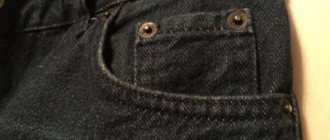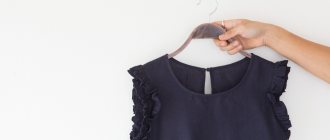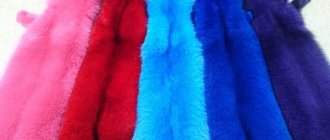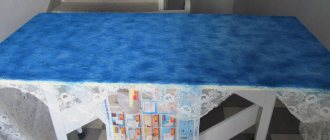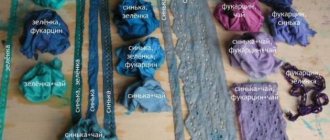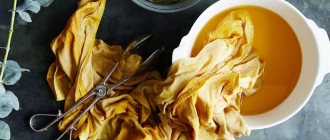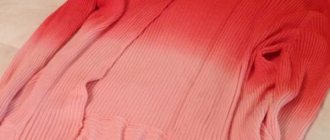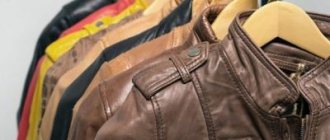Share on social media networks:
Almost every home has a blazer in their closet. These jackets come in different styles and colors. In addition, the cost is quite reasonable, so many can afford to buy such a thing. But sometimes it happens that the color of winter outerwear gets boring, and a person immediately looks for a solution to his problem. Owners of such products often wonder how to dye a bologna jacket at home? How to decorate bolognese pants? How to dye a black nylon parka? First you need to understand the tools and paints, and also not forget about the properties of the material and dyes.
Preparatory work
Before you start dyeing, you need to prepare the jacket:
- unfasten or unfasten the fur collar and cuffs;
- remove buttons;
- fasten the clasps;
- remove everything from pockets;
- oil or glue stains on the surface of the fabric must be removed in advance using special means;
- A dirty jacket needs to be washed.
The workplace also requires preparation. To protect floors, walls and other surfaces from paint, you need to cover the work area with plastic film. Just in case, you need to put napkins, a rag and detergent in a visible place. If paint spills out of the container, you can immediately remove the puddle without waiting for the dye to be absorbed. In addition, you need to take care to protect your own clothing.
For work you will need the following items and materials:
- Dye - sold in powder form, which must be diluted with water in the proportions specified in the instructions.
- Container - a large aluminum pan or tank. After immersing the jacket in the dye solution, the container should be filled only 2/3 of the volume.
- Scales.
- Wooden tongs for stirring clothes.
- Salt, vinegar.
Once everything is prepared, you can safely start dyeing your clothes.
General rules for dyeing a jacket
Experienced housewives know that repainting any clothes, especially a jacket, with their own hands is quite difficult. Therefore, for those who decided to do such an experiment for the first time, it is better to practice on old clothes that you don’t mind throwing away. The dyeing process consists of several stages:
- Using household scales, determine the mass of the product. This is necessary in order not to make a mistake with the amount of dye. The manufacturer always indicates how much paint is required depending on the weight of the jacket. To obtain a more saturated color, you need to take a little more coloring powder.
- The washed and stain-free jacket is soaked in warm water for half an hour. This will allow the dye to be evenly distributed throughout the entire product.
- Water is poured into the prepared container and heated to a temperature of 60 °C.
- The dye is diluted in a separate saucepan, for which a packet of powder is poured with a glass of hot water and mixed thoroughly. Liquid paint should also be dissolved in a small amount of water and only then poured into a container. Advice! To obtain a bright, rich color, add 100 ml of acetic acid to the container with the coloring solution.
- Place the pan with the dye solution on the stove, lower the jacket into the liquid and heat the water to boiling point. The jacket should be cooked over low heat for at least 20 minutes. During dyeing, while the container is on the stove, you must carefully stir the clothing with wooden tongs or a regular stick, trying to prevent the item from floating to the surface of the solution.
- At the end of the process, to fix the paint, pour a brine solution into the container, combining 50 g of table salt and 2 liters of water, and boil for a few more minutes.
- After the time specified in the instructions has passed, the jacket is removed from the solution and rinsed twice - the first time in cool water, the second time with the addition of 30 ml of vinegar.
How to dye a bolognese jacket
Jackets and raincoats made of Bolognese fabric are often found on sale. This material is wear-resistant, which cannot be said about dyes. Over time, a Bolognese jacket loses its respectable appearance and looks shabby.
Dyeing bolognese fabric is difficult, but not impossible. The fact is that dyeing fabrics requires boiling, and nylon fabric treated with a polymer composition does not tolerate exposure to such high temperatures, that is, it is definitely impossible to cook a Bolognese jacket. In addition, the structure of this material is easily destroyed under the influence of chemical solvents.
There is only one way out of this situation - to use paints for synthetic materials: nylon, acrylic, nylon. Dyeing with these products does not require boiling, and the entire process takes place using water at a temperature of 50 °C. The item is immersed in a container with dye and soaked for as long as required according to the instructions. As a result, the jacket acquires an attractive, rich color.
Features of choosing a dye
When deciding to renew faded clothing, you first need to study the composition of the material from which it is made. You can easily dye a jacket made of cotton, denim, or linen. But with synthetic fabrics you will have to tinker. Some synthetics cannot be painted at all - the paint simply flows off the surface of the product like water.
Polyester is often used as a synthetic material for outerwear. Jackets made from this fabric do not get wet, get dirty little, and last a long time. If the fabric is 100% polyester, it will be very difficult to dye. It is better when the material contains additional fibers such as cotton, linen, viscose, and the percentage of their content is at least 40.
Often, manufacturers of synthetic materials used for sewing outerwear treat the surface of the fabric with a special water-repellent composition. A thin protective film prevents paint from penetrating into the fibers of the material, which significantly complicates the dyeing process. The label always mentions the presence of such impregnation, so before starting painting it is very important to study all the information about your product.
The final coloring result is significantly influenced by the original color of the product. On the packaging of their product, the manufacturer always indicates the color that should be obtained after processing. We must remember that this only applies to dyeing white things. Otherwise, the result may be unpredictable. To paint colored items, it is better to choose a paint that is a shade darker.
We dye the jacket
- Before dyeing your outerwear, soak it in warm water. This is necessary to ensure that the paint is evenly distributed throughout the jacket. You can soak it in the sink or in a bucket.
- Next, remove the bolognese jacket from the water and straighten out all the creases and folds so that the dye will subsequently lie evenly on its surface.
- Heat a large pan of water. Pour water so that the jacket floats freely.
Important! The product must float freely in water. This way the paint can be absorbed evenly. The size of the pan should be such that after immersing the product, it is three-quarters full. It is recommended to choose a very large container so as not to make a mistake.
- Bring water to a boil over low heat. Then we pour water into a basin and immerse our product in the resulting “bath”. Make sure the water is at least 60 degrees Celsius.
- Add the colorful solution to a pan of boiling water and stir for a few minutes. One bag of paint will require at least 11 liters of water. If you take less, the color will be more saturated. And if it’s the other way around, then the shade will accordingly be less bright.
Important! Dissolve the dye in a separate container. Fill a bag of powder with 200 ml of hot water. Stir until completely dissolved. If you use liquid paint, you must first dissolve it with water.
- To get a brighter and more colorful result, you can add white vinegar to the water. For 11 liters of water you will need 100 ml of vinegar.
- You need to “cook” the jacket for at least one hour.
How to update the color of a leather jacket
Outerwear made from genuine leather is durable and can last for decades. If your favorite leather jacket is slightly frayed, whitish cracks and bald spots appear in the cuffs, pockets and fasteners, then it’s time to update the product by dyeing it.
To carry out this difficult event you will need not only special paint, but also experience. Therefore, if such a possibility exists, it is better to take your leather jacket to a dry cleaner, where professionals will take care of it. For those who decide to restore skin color with their own hands, the following recommendations will be useful:
- For dyeing a leather jacket, the best paints are those made by such well-known foreign companies as Salamander and Tarrago. They are available in the form of an aerosol or paste.
- To prevent worn areas from looking like patches after painting, you will have to process the entire product.
- There is no need to radically change the color of the jacket, much less repaint it from dark to light. The result in this case will be unpredictable. You can only update the product by choosing a paint that is close in tone to the original color.
It is much more convenient to work with paint in aerosol form than with paste or liquid. It is best to carry out painting outdoors, where you do not have to worry about the cleanliness of furniture and walls.
- The leather surface is wiped with a damp foam sponge.
- The jacket is hung on hangers so that the bottom of the product does not touch the floor.
- Spray the paint evenly over the surface of the jacket and wait until the applied layer dries completely.
- Re-spray the paint.
Painting with liquid or paste paint requires a lot of effort. In this case, the jacket is laid out on a horizontal surface, and the paint is applied using a piece of foam rubber, carefully treating every centimeter of the leather surface.
Having mastered the art of dyeing at home, you can always update a worn jacket or jeans. The main thing is to use high-quality dyes and follow the manufacturer’s recommendations on the proportions of paint dilution and methods of applying it.
Step-by-step instructions for dyeing fabric
The fabric to be dyed should be soaked in warm water for approximately 15–20 minutes. At the same time, you need to boil a liter of water in an enamel pan. Pour the contents of the fabric dye bag into it and mix vigorously. Add another 1.5 liters of hot water to the dissolved dye in the pan and, after stirring, immerse the fabric intended for dyeing in it. After this, put the pan on the gas and simmer over low heat for about 30 minutes, stirring with a metal spoon every few minutes. All this time, the material must be completely immersed in the dye.
Over time, any outerwear loses its original appearance. The color of a jacket or coat noticeably fades, causing the item to become dull and unsightly. Aniline or acrylic fabric dyes, which can be purchased today at any hardware store, will help correct the situation. The choice of paint and dyeing technology depends on the color and composition of the material from which the clothing is made. Those dyes that are great for natural fabrics are not always able to color synthetics. Therefore, in order for restoration work at home to be successful, it is necessary to choose the right coloring composition and strictly follow the instructions drawn up by the manufacturer.


